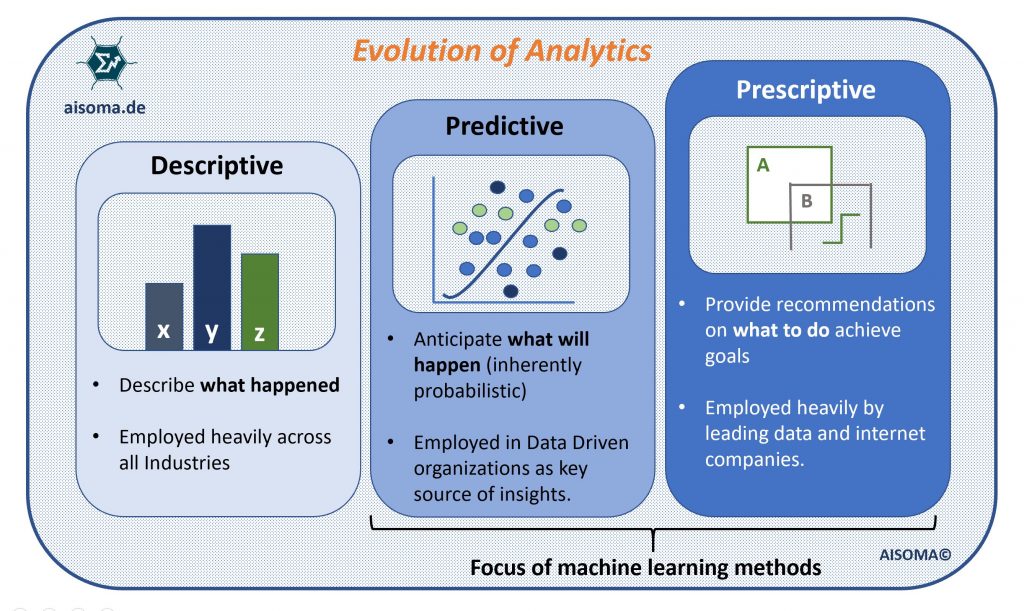Predictive Analytics applications enable companies to identify and predict potential events and opportunities on time.
Wikipedia defines predictive analytics as follows:
“Predictive Analytics’ encompasses a variety of statistical techniques from data mining, predictive modeling, and machine learning, that analyze current and historical facts to make predictions about future or otherwise unknown events.”
(Source: Wikipedia)

1. Customer Churn
If a company loses customers, it must win new customers to compensate for the loss in sales. This can be very expensive because the costs of gaining new customers are usually much higher than the existing customer loyalty. Predictive analyses help to avoid churn in your customer base by detecting signs of dissatisfaction among your customers in time and identifying those customers or customer segments that pose the highest risk of leaving. With this information, companies can take timely action to satisfy these customers.
Key industries: Automotive, Banking, Insurance, Retail, Telecommunications
2. Value of Customer Lifetime Value
One of the most challenging things in marketing is to identify the customers who will spend the most money (this should be done in the most consistent way and over a more extended period). This kind of insight allows companies to optimize their marketing. This can increase the share of each business segment to attract and retain those customers who have the highest lifecycle value for your business.
Key industries: Banking, Insurance, Retail, Telecommunications, Utilities
3. Customer Segmentation
Different companies define their markets differently and segment their markets according to the aspects that offer the highest value for their industry, products, and services. Good use of predictive analytics is to identify target markets based on real data and indicators and to identify the segments of those markets that are most receptive to what your company offers. The same data can also help identify segments and potentially even entire markets that you didn’t even know existed.
Key industries: Automotive, Banking, Life Sciences/Pharmaceuticals, Insurance, Retail, Telecommunications, Utilities
4. Next Best Action
The definition of your primary market segments and customers is a critical application case for predictive analytics. But this only gives an incomplete picture of what your marketing approach should look like. Analytics can also provide insight into the best way to reach individual customers within these segments by analyzing everything from buying patterns to consumer behavior to social media interactions that give you insight into the best times and channels to connect with those customers.
Key industries: Banking, Education, Insurance, Telecommunications
5. Predictive Maintenance
In many industries, cost containment is a valuable strategy and increases sales. For companies with significant investments in infrastructure and equipment, the ability to manage these investments is critical. By analyzing metrics and data related to the lifecycle maintenance of technical assets, companies can predict both schedules for probable maintenance events and future investment needs so they can streamline maintenance costs and avoid critical downtime.
Key Industries: Automotive, Manufacturing, Logistics & Transportation, Oil & Gas, Utilities
6. Product Inclination (product propensity)
Product Propensity Analytics combines data on purchasing activity and behavior with online behavior metrics from social media and e-commerce and correlates this data to gain insight into the effectiveness of various campaigns and social media channels when it comes to your company’s products and services. This enables your company to predict not only which customers are more likely to buy your products and services, but also which channels those customers are most likely to reach, so you can maximize the channels that have the best chance of generating significant revenue.
Key industries: Banking, Insurance, Retail
7. Quality Control (Predictive Quality / Quality Assurance)
Quality control is critical not only to customer satisfaction but also to your bottom line and operating costs. Over time, inefficient quality control will affect your customer satisfaction, purchasing behavior and ultimately sales and market share. Poorer quality control results in higher costs for customer support, warranty claims and repairs, and less efficient manufacturing. However, sophisticated predictive analytics can provide insight into potential quality issues and trends before they become truly critical issues.
Key industries: Automotive, Life Sciences/Pharmaceuticals, Manufacturing, Logistics & Transportation, Oil & Gas, Power Supply
8. Risk Modeling
Risks occur in various forms and can originate from a variety of sources. Predictive analytics can identify potential, as well as trends in the data that suggest the development of situations that may affect business and results. By combining these analyses with a rigorous risk management approach, companies can identify and quantify risk problems, evaluate them and decide how to mitigate risk factors that are considered critical.
Key industries: Automotive, Banking, Manufacturing, Logistics & Transport, Oil & Gas, Utilities
9. Sentiment Analysis
It is challenging to be always and everywhere, especially in the online world. Likewise, it is virtually impossible to capture and verify everything that is said about your company or organization. However, by combining web search and crawling tools with customer feedback and contributions, you can create analytics that gives you a picture of your company’s reputation in your key markets and demographics and proactively recommends how best to improve that reputation.
Key Industries: Life Sciences/Pharmacy, Education, Insurance, Retail, Telecommunications
10. Up- and Cross-Selling
Your customer base is the source of both existing revenue and your company’s revenue growth. That’s why it’s essential to maximize the revenue opportunities available in your market segment and product set. Predictive analytics can suggest which products can be combined to address which market segments to increase both your value to your customers and your customers’ revenue.
Key Industries: Banking, Insurance, Retail, Telecommunications
With Predictive Analytics, you can go beyond simple reactive operations to proactive and predictive activities that help you plan for the future and identify new business opportunities.
[bctt tweet=”10 Predictive Analytics Use Cases #PredictiveAnalytics #BigDataAnalytics #MachineLearning #Marketing #CustomerSuccess” username=”AISOMA_AG”]
Recommended article: 5 Variations of AI